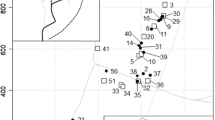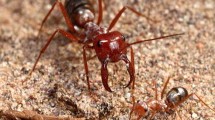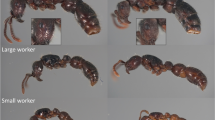Abstract
Desert ants of the genus Cataglyphis evolved a remarkable diversity in their reproductive strategies. In Cataglyphis species where social organisation was described so far, colonies are headed by one or multiple queens, queens being singly or multiply mated, and workers and/or queens possess the ability to reproduce asexually via thelytokous parthenogenesis. Here, we investigate the social organisation of C. bombycina (group bombycinus) and C. theryi (group albicans) using highly polymorphic microsatellite markers. Our results show that both species are characterized by monogynous colonies and multiply mated queens, supporting the idea that polyandry is an ancestral trait of the genus. No evidence for parthenogenetic reproduction by queens was found. One distinctive feature of the species C. bombycina among the genus is the presence of a morphologically distinct soldier caste, with highly developed scythe blades jaws. In the only colony where a significant number of soldiers have been sampled, the distribution of patrilines is fundamentally different between the soldier and the worker caste. This result suggests a genetic contribution to worker caste determination in this species, and certainly awaits further investigation.
Similar content being viewed by others
References
Agosti D. 1990. Review and reclassification of Cataglyphis (Hymenoptera, Formicidae). J. Nat. Hist. 24: 1457–1505
Amor F., Ortega P., Jowers M.J., Cerda X., Billen J., Lenoir A. and Boulay R.R. 2011. The evolution of worker-queen polymorphism in Cataglyphis ants: interplay between individual- and colony-level selections. Behav. Ecol. Sociobiol. 65: 1473–1482
Arnqvist G. and Nilsson T. 2000. The evolution of polyandry: multiple mating and female fitness in insects. Anim. Behav. 60: 145–164
Aron S., Timmermans I. and Pearcy M. 2011. Ant queens adjust egg fertilization to benefit from both sexual and asexual reproduction. Biol. Lett. 7: 571–573
Avise J.C. 2008. Clonality: The Genetics, Ecology, and Evolution of Sexual Abstinence in Vertebrate Animals. Oxford University Press, Oxford
Baer B., Armitage SAO. and Boomsma J.J. 2006. Sperm storage induces an immunity cost in ants. Nature 441: 872–875
Baer B. and Schmid-Hempel P. 1999. Experimental variation in polyandry affects parasite loads and fitness in a bumble-bee. Nature 397: 151–154
Boomsma J.J., Kronauer D.J.C. and Pedersen J.S. 2009. The evolution of social insect mating systems. In: Organization of Insect Societies—From Genome to Sociocomplexity (Gadau J. and Fewell J., Eds). Harvard University Press, Cambridge, Massachusetts, pp 3–25
Boomsma J.J. and Ratnieks F.L.W. 1996. Paternity in eusocial Hymenoptera. Phil. Trans. R. Soc. B. 351: 947–975
Brown M.J.F. and Schmid-Hempel P. 2003. The evolution of female multiple mating in social Hymenoptera. Evolution 57: 2067–2081
Cagniant H. 1973. Apparition d’ouvrières à partir d’oeufs pondus par des ouvrières chez la fourmi Cataglyphis cursor Fonscolombe (Hymenoptères, Formicidae). C.R. Hebd. Seanc. Acad. Sci. Ser. D. Sci. Nat. 277: 2197–2198
Cagniant H. 2009. Le genre Cataglyphis Foerster, 1850 au Maroc (Hyménoptères Formicidae). Orsis 24: 41–71
Cerdá X. 2001. Behavioural and physiological traits to thermal stress tolerance in two Spanish desert ants. Etologia 9: 15–27
Chapman T., Liddle L.F., Kalb J.M., Wolfner M.F. and Partridge L. 1995. Cost of mating in Drosophila melanogaster females is mediated by male accessory-gland products. Nature 373: 241–244
Cheron B., Cronin A.L., Doums C., Federici P., Haussy C., Tirard C. and Monnin T. 2011. Unequal resource allocation among colonies produced by fission in the ant Cataglyphis cursor. Ecology 92: 1448–1458
Clémencet J., Viginier B. and Doums C. 2005 Hierarchical analysis of population genetic structure in the monogynous ant Cataglyphis cursor using microsatellite and mitochondrial DNA markers. Mol. Ecol. 14: 3735–3744
Cronin A., Molet M., Doums C., Monnin T. and Peeters C. 2013. Recurrent evolution of dependent colony foundation across eusocial insects. Annu. Rev. Entomol. 58: 37–55
Crozier R.H. and Fjerdingstad E.J. 2001 Polyandry in social Hymenoptera—disunity in diversity? Ann. Zool. Fennici 38: 267–285
Crozier R.H. and Page R.E. 1985. On being the right size—Male contributions and multiple mating in social Hymenoptera. Behav. Ecol. Sociobiol. 18: 105–115
Crozier R.H. and Pamilo P. 1996. Evolution of Social Insect Colonies, Sex Allocation and Kin-Selection. Oxford series in ecology and evolution. Oxford University Press, Oxford
Dartigues D. and Lenoir A. 1990 La ponte des ouvrières Cataglyphis F (Hymenoptera: Formicidae): mise en évidence d’une parthénogenèse thélytoque. Ann. Soc. Entomol. Fr. 26: 121–123
Délye G. 1956. Ecologie de quelques fourmis dans les régions humides de l’Algérie (Camponotus alii For.; C. sylviaticus Ol.; Aphaenogaster testaceopilosa Lucas). Bull. Soc. Hist. Nat. Afr. Nord. 47: 191–199
Délye G. 1957. Observations sur la fourmi saharienne Cataglyphis bombycina Rog. Insect. Soc. 4: 77–82
den Boer S.P.A., Baer B. and Boomsma J.J. 2010. Seminal fluid mediates ejaculate competition in social insects. Science 327: 1506–1509
Evison S.E.F. and Hughes W.O.H. 2011. Genetic caste polymorphism and the evolution of polyandry in Atta leaf-cutting ants. Naturwissenschaften 98: 643–649
Eyer P.A., Leniaud L., Darras H. and Aron S. 2013. Hybridogenesis through thelytokous parthenogenesis in two Cataglyphis desert ants. Mol. Ecol. 22: 947–955
Fjerdingstad E.J. 2012. Multiple mating and offspring quality in Lasius ants. Insect. Soc. 59:183–191
Fraser V.S., Kaufmann B., Oldroyd B.P. and Crozier R.H. 2000. Genetic influence on caste in the ant Camponotus consobrinus. Behav. Ecol. Sociobiol. 47: 188–194
Goudet J. 1995. FSTAT (vers 1.2): A computer program to calculate F-statistics. J. Heredity 86: 485–486
Hardy O.J., Pearcy M. and Aron S. 2008. Small-scale spatial genetic structure in an ant species with sex-biased dispersal. Biol. J. Linn. Soc. 93: 465–473
Hölldobler B. and Wilson E.O. 1990. The Ants. Harvard University Press, Cambridge, Mass
Holman L., Sturup M., Trontti K. and Boomsma J.J. 2011. Random sperm use and genetic effects on worker caste fate in Atta colombica leaf-cutting ants. Mol. Ecol. 20: 5092–5102
Hughes W.O., Sumner S., Van Borm S. and Boomsma J.J. 2003. Worker caste polymorphism has a genetic basis in Acromyrmex leaf-cutting ants. Proc. Natl. Acad. Sci. USA. 100: 9394–9397
Jaffé R., Kronauer D.J., Kraus F.B., Boomsma J.J. and Moritz R.F.A. 2007. A genetic component to worker caste determination in the army ant Eciton burchellii. Biol. Lett. 3: 513–516
Jennions M.D. and Petrie M. 2000. Why do females mate multiply? A review of the genetic benefits. Biol. Rev. 75: 21–64
Jones T.H., Clark D.A., Edwards A.A., Davidson D.W., Spande T.F. and Snelling R.R. 2004. The chemistry of exploding ants, Camponotus spp. (cylindricus complex). J. Chem. Ecol. 30: 1479–1492
Jowers M.J., Leniaud L., Cerdá X., Alasaad S., Caut S., Amor F., Aron S. and Boulay R. Social and population structure in the ant Cataglyphis emmae: Adaptive mating strategies and dispersal. PLoS ONE, submitted
Keller L. 1991. Queen number, mode of colony founding, and queen reproductive success in ants (Hymenoptera Formicidae). Ethol. Ecol. Evol. 3: 307–316
Knaden M., Tinaut A., Stokl J., Cerda X. and Wehner R. 2012. Molecular phylogeny of the desert ant genus Cataglyphis (Hymenoptera: Formicidae). Myrmecol. News 16: 123–132
Knaden M. and Wehner R. 2006. Fundamental difference in life history traits of two species of Cataglyphis ants. Front. Zool. 3: 21
Leniaud L., Darras H., Boulay R. and Aron S. 2012. Social hybridogenesis in the clonal ant Cataglyphis hispanica. Curr. Biol. 22: 1188–1193
Leniaud L., Heftez A., Grumiau L. and Aron S. 2011. Multiple mating and supercoloniality in Cataglyphis desert ants. Biol. J. Lin. Soc. 104: 866–876
Lenoir A., Quérard L., Pondicq N. and Berton F. 1988. Reproduction and dispersal in the ant Cataglyphis cursor (Hymenoptera, Formicidae). Psyche 95: 21–44
Maichier V. 2012. Origine évolutive d’un nouveau phénotype chez Cataglyphis bombycina: une étude morphométrique. Dissertation, Université Pierre et Marie Curie
Mattila H.R. and Seeley T.D. 2007. Genetic diversity in honey bee colonies enhances productivity and fitness. Science 317: 362–364
Nielsen R., Tarpy D.R. and Reeve H.K. 2003. Estimating effective paternity number in social insects and the effective number of alleles in a population. Mol. Ecol. 12: 3157–3164
Pearcy M., Aron S., Doums C. and Keller L. 2004a. Conditional use of sex and parthenogenesis for worker and queen production in ants. Science 306: 1780–1783
Pearcy M., Clemencet J., Chameron S., Aron S. and Doums C. 2004b. Characterization of nuclear DNA microsatellite markers in the ant Cataglyphis cursor. Mol. Ecol. Notes 4: 642–644
Pearcy M., Timmermans I., Allard D. and Aron S. 2009. Multiple mating in the ant Cataglyphis cursor: testing the sperm limitation and the diploid male load hypotheses. Insect. Soc. 56: 94–102
Pisarski B. 1965. Les fourmis du genre Cataglyphis en Irak (Hymenoptera Formicidae). Bull. Ac. Pol. Sc-Series Sc. Biol. 13: 417
Queller D.C and Goodnight K.F. 1989. Estimating relatedness using genetic-markers Evolution 43: 258–275
Ratnieks F.L.W. 1988. Reproductive harmony via mutual policing by workers in eusocial Hymenoptera. Am. Nat. 132: 217–236
Ratnieks F.L.W. 1989. Conflict and cooperation in insect societies. Ph.D. dissert, Cornell University, Ithaca
Ratnieks F.L.W. and Boomsma J.J. 1995. Facultative sex allocation by workers and the evolution of polyandry by queens in social Hymenoptera. Am. Nat. 145: 969–993
Ratnieks F.L.W., Foster K.R. and Wenseleers T. 2006. Conflict resolution in insect societies. Annu. Rev. Entomol. 51: 581–608
Rheindt F.E., Strehl C.P. and Gadau J. 2005. A genetic component in the determination of worker polymorphism in the Florida harvester ant Pogonomyrmex badius. Insect. Soc. 52: 163–168
Robinson G.E. and Page R.E. 1988. Genetic determination of guarding and undertaking in honeybee colonies. Nature 333: 356–358
Rousset F. 1997. Genetic differentiation and estimation of gene flow from F-statistics under isolation by distance. Genetics 145: 1219–1228
Rousset F. 2008. Genepop’007: a complete re-implementation of the Genepop software for Windows and Linux. Mol. Ecol. Resour. 8: 103–106
Schmid-Hempel P. 1998. Parasites in Social Insects. Princeton University Press, Princeton
Schwander T. and Keller L. 2012. Evolution: sociality as a driver of unorthodox reproduction. Curr. Biol. 22: R525–R527
Schwander T., Rosset H. and Chapuisat M. 2005. Division of labour and worker size polymorphism in ant colonies: the impact of social and genetic factors. Behav. Ecol. Sociobiol. 59: 215–221
Seeley T.D. and Tarpy D.R. 2007. Queen promiscuity lowers disease within honeybee colonies. Proc. R. Soc. B. 274: 67–72
Sherman P.W., Seeley T.D. and Reeve H.K. 1988. Parasites, pathogens, and polyandry in social Hymenoptera. Am. Nat. 131: 602–610
Slatyer R.A., Jennions M.D. and Backwell P.R.Y. 2012a. Polyandry occurs because females initially trade sex for protection. Anim. Behav. 83: 1203–1206
Slatyer R.A., Mautz B.S., Backwell P.R.Y. and Jennions M.D. 2012b. Estimating genetic benefits of polyandry from experimental studies: a meta-analysis. Biol. Rev. 87: 1–33
Timmermans I., Grumiau L., Hefetz A. and Aron S. 2010. Mating system and population structure in the desert ant Cataglyphis livida. Insect. Soc. 57: 39–46
Timmermans I., Hefetz A., Fournier D. and Aron S. 2008. Population genetic structure, worker reproduction and thelytokous parthenogenesis in the desert ant Cataglyphis sabulosa. Heredity 101: 490–498
Trivers R.L. and Hare H. 1976. Haplodipoidy and the evolution of the social insects. Science 191: 249–263
Van Oosterhout C., Hutchinson W.F., Wills D.P.M. and Shipley P. 2004. MICRO-CHECKER: software for identifying and correcting genotyping errors in microsatellite data. Mol. Ecol. Notes 4: 535–538
Walsh P.S., Metzger D.A. and Higuchi R. 1991. Chelex 100 as a medium for simple extraction of DNA for PCR-based typing from forensic material. Bio.Techniques 10: 506–513
Wang J.L. 2004. Sibship reconstruction from genetic data with typing errors. Genetics 166: 1963–1979
Wenseleers T. and Ratnieks F.L.W. 2006. Comparative analysis of worker reproduction and policing in eusocial Hymenoptera supports relatedness theory. Am. Nat. 168: E163–E179
Acknowledgments
We thank A. Tinaut, R. Boulay and M. Jowers for their help in field sampling and L. Lechevalier for technical assistance. This work was supported by grants from the Belgian FRS-FNRS (L. L. and M. P.) and Action de Recherché Concertée (S. A.).
Author information
Authors and Affiliations
Corresponding author
Rights and permissions
About this article
Cite this article
Leniaud, L., Pearcy, M. & Aron, S. Sociogenetic organisation of two desert ants. Insect. Soc. 60, 337–344 (2013). https://doi.org/10.1007/s00040-013-0298-2
Received:
Revised:
Accepted:
Published:
Issue Date:
DOI: https://doi.org/10.1007/s00040-013-0298-2




